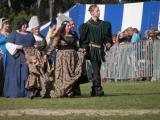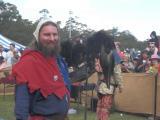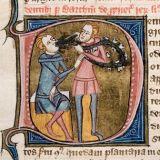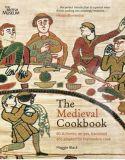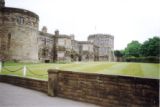Barbara Gaskell Denvil was born in England, grew up amongst artists and authors and started writing at a young age. She published numerous short stories and articles, and worked as an editor, book critic and reader for publishers and television companies. About 10 years ago she began writing medieval novels (mystery, romance, murder-adventure) set principally in 15th century England.
Her first medieval novel Satin Cinnabar is a historical crime adventure set in London during the last months of 1485 in the aftermath of the Battle of Bosworth. It is available for Amazon Kindle and all other ebook readers (Barnes & Noble, Kobo, Sony, ipad etc..)
Her new novel Sumerford’s Autumn is also set during the last years of the 15th century and will make major reference to the fate of both King Edward IV’s sons. It will be published for Kindle later this month or early in April.
Barbara also writes fantasy, though this tends to be more dark and adult. Her fantasy novel Fair Weather is set in medieval England around the early 1200s. There’s a fair chunk of historical content, but the basic plot is pure fantasy. It is also available for Amazon Kindle and from Smashwords in other formats.
Barbara’s novels are gripping and engrossing stories, real page turners, involving believable characters to carry the story along, while maintaining a high level of historical accuracy.
After reading Satin Cinnabar, we asked Barbara to tell us more about the medieval world she describes so masterfully in the novel. This is the second part of her article “Medieval Life”, part 1 and part 2 were on this site previously. Thank you, Barbara, for sharing this with us.
Don’t forget to visit Barbara’s blog.
———————————————————————————————————————————–
However, not everything was risk and danger, and justice was far more readily available than many people now assume.
There was no organised police force of course, but there were sheriffs, constables, judges, law courts, solicitors, lawyers, and a careful system of law and order. This was sometimes open to bribery and corruption (Richard III took pains to try and eliminate some of this corruption) but folk were not generally vulnerable to outright anarchy and destruction. It is sometimes thought, for instance, that while ‘usurping’ the throne by force, Richard III was backed by a marauding army and therefore simply intimidated everyone into supporting him. This is absurd. This sort of thing did not happen either in his case, or for anyone else by the 15th century. Sometimes in some rural backwater the local lord might achieve some fairly horrid results in this manner, but this sort of feudalism was no longer possible to maintain, and criminals were usually brought to justice.
As a deterrent, execution was brutal. Nobility was beheaded, and that could take several strokes of a blunt axe wielded by a slovenly or even drunken executioner. Nobility was, however, often pardoned before the final act, depending on the crime. The common man was hanged, and if his crime was sufficiently heinous, especially if it involved treachery to the crown, he could be hung, drawn and quartered. He could also be cut down from the noose before dead, and publicly castrated. This had been accepted practise in previous eras, but by the mid to late 1400s this practise was dying out. Heretics could be burned, but NOT witches. Witches were not classed as heretics until the 17th century, and during medieval times witchcraft had no association with devil worship. Witches were often herbalists and midwives, wise women and astrologers. As long as they did not attempt to kill anyone or predict the king’s death – a crime punishable by execution – astrology was generally practised and in fact was an acceptable part of diagnosis and medicine.
Public execution is often now depicted as a callous celebration and a good day out for the local citizens, but the public nature of the spectacle was originally designed as a deterrent, not a diversion. Good men dragged along their sons to show them what terrible consequences came from evil living. Women sobbed and hid their eyes. Men offered a last cup of beer to the unfortunate condemned. Those who had been wronged were able to see justice done, and relatives could say goodbye. Some no doubt enjoyed the drama, but this was not the general attitude.
Prisons were appalling places and the conditions for the inmates were atrocious. However, torture was not used. It was entirely illegal in England until Tudor times. The Tower of London, now so closely associated with dungeons, torture and death, was simply a royal palace before the reign of Henry VII. It was used as luxury apartments, as a meeting chamber for the Royal Council, celebrations and feasting, as well as occasionally housing the rare important prisoner. The so called ‘princes in the Tower’ were not imprisoned. They were originally housed in the vast refurbished Royal Apartments while awaiting Edward V’s coronation, and even after this was cancelled, they were removed to other comfortable apartments. Those staying here had servants, access to the gardens and battlements, and could please themselves in many ways, sometimes even those who were denied the freedom to leave. There was even a zoo. Indeed, the Tower was busily occupied with a huge and bustling household. No damp silent stone, no dark secrets, no unlit and unused stairways, torture chambers or haunted corridors.
Unfortunately the Tudor dynasty brought many changes. Under some circumstances the rack was subsequently used, and although special permission was supposed to be given for the use of torture, other methods of persuasion were no kinder. Confessions during the reigns of Henry VII, Henry VIII and the other Tudor monarchs were frequently obtained under torture and it is high time some of these confessions were seen as the useless and miserable lies they clearly were.
During Henry VII’s monarchy the rising middle classes and the growing independence of women also took a backward step. A great deal of this was due to Henry Tudor’s extremely severe methods of high taxation and his suspicious attitude towards his powerful nobles, whether allies or enemies. Some deterioration of lifestyle was also due to foreign wars and politics which influenced trade, and some was due to the start of worsening weather conditions. Britain and Europe’s warm period was coming to an end and the Earth was cooling. Within a few short years the Little Ice Age was starting to form. Poverty and beggary soared, and prostitution increased due to this growing destitution.
This was in direct contrast to the gradual improvement in living conditions during the reigns of the Plantagenets, in spite of occasional famines and prolonged storms. At that time the country was slowly becoming prosperous and a burgeoning middle class was expanding. Of course, what your actual business was would determine your way of life. Some jobs involved such noxious practises, (and this in a world where strong natural smells were an accepted part of life) they were banned from carrying out their trades within proximity of other dwellings. Other trades remained a struggle with long hours and little pay, but inflation was virtually non existent, and the cost of living remained generally stable.
And the butcher, the baker and the candlestick maker? No trade unions back then of course but the appropriate Guild would protect you, oversee your practises, watch over your apprentices, put on plays at Christmas and generally promote your business.
So before the trials of the Tudor dawn, life was improving for most. It was a small world, a cosy world, friendly, chattering and smelly. The population was so very much smaller than today and it was normal for people to be closely acquainted with all their neighbours. This – and the difficulty in getting hold of accurate news – created another of most people’s favourite pastimes – gossip and rumour.
The friendly neighbourliness could mean protection, someone to watch the children when you had to work, someone to bring you chicken broth when you were sick, someone to share their oats and parsnips when you lost your job, and even someone to adopt the baby if you suddenly died young. But this also carried its disadvantages – for those same friendly neighbours knew virtually everything you did, commented on it, criticised it, and gossiped far and wide about it.
So – the good, the bad, and the ugly!
And the rest is another story ————–
Tags: Justice, Medieval Life

